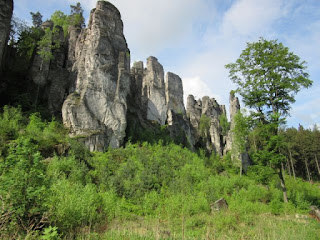I have been pondering
whether to post about the British EU Referendum for several weeks. And now I have finally
put fingers to keyboard. We bought our Czech house in 2004, so we are
approaching the twelfth year of our Czech adventure. During those
years I have continued to live in both countries, moving freely
between the two, although I have spend the majority of my time in England with my husband. In 2007 I started this blog with the stated aim to
help the British understand the Czechs and vice versa. So I would be
failing if I did not post about the possible Brexit
What
has triggered this post was a load of comments on a YouGov survey.
One commentator said that the Remainers had to decide whether they
were British or European, a view supported by other Brexiteers. My
answer is I do not have to decide any such thing. One of the things I
have learned over the last twelve years is that you can be both.
Indeed you can have many identities. I am British and European, I
even consider myself to be a little Czech. I am also English and
British. When I spend time with my Australian friend, as I did last
week, I am conscious we share a common heritage and Commonwealth
identity. Even if we do leave the EU, I will still be European and
proud of it. Because Europe is also about shared culture, history and
view of the world, something my time with Czechs has made very aware
of. In truth we have far more alike than different.
Here
in the Czech Republic I am the outsider, the foreigner who might be
accused of taking away an affordable home from young Czechs. I even
have failed miserably to master the Czech language. And yet the
Czechs have welcomed me. The leaders of
Brexit say that EU citizens don't have to worry about being forced
out. But I have no doubt that if the roles were reversed and I
encountered from Czechs the levels of xenophobia and hostility
expressed in those comments and in the press and media, I would
seriously be thinking of selling up and leaving. I am sure the same
is true of Czechs in the UK now. Even if the UK opts to Remain, I
fear we have already done a lot of damage to the trust between our
peoples.
One
of the tragedies of this is the loss of benefits the Czech and other
EU migrants bring to our country. I am not just talking about the
lovely carer who comes every morning to help my frail elderly mother
or my excellent Polish NHS dentist, but about the fact that mutual
understanding is the best driver of trade and commerce. My blog promotes the Czech Republic and I know of plenty of Czechs who have
returned to their homeland and continue to do business which is
favourable to the UK.
As a
historian I was struck by the total nonsense some of the commentators
came out with. Over and over they kept talking about how we needed to
make Britain great again, how we were better going it on our own,
with (I could hardly believe it) lots of references to Dunkirk and
our finest hour. This is all based on
historical myth. There is no historic precedent for what is proposed.
We have been in some sort of supra-national alliance – be it
Empire, Commonwealth, or European Union for over three centuries. We
were not alone after Dunkirk. Indeed Churchill's finest hour belongs
not to the British but to the citizens of the British Empire and
Commonwealth, and moreover he talks about the Czech, Polish, French
and other nationals, who had come to Britain to fight. This myth of Britain standing
alone does a disservice for all those who fought by our side in those
dark hours and especially those that died.
I have been
researching the Czech RAF pilots for my next book and my admiration
and gratitude to them is enormous.
When
I first read those comments, I was angry – angry on behalf of the
Czechs and on behalf of my son and the young people of his generation,
who would be denied the chance to enjoy the freedom to live, travel and work anywhere in Europe. Now in
retrospect I am sorry for the commentator and his narrow,
backward-looking world views. I am sorry too to all those young
Czechs living in the UK who find themselves subjected to those views.
A note about bias
I am
sure if those commentators were to see this post, they would
sneeringly dismiss me as being biased, of having a self interest in
the result of the Referendum. And it is true that I am worried by a Leave Vote. My
currency broker friend tells me the £ will collapse in the event of a Leave
vote and I believe him (after all he will make money either way). I am also worried that the cost of living in the Czech
Republic will rise to an extent that I will not be able afford to be
here and really will have to choose between the UK and the Czech
Republic. But that said, I was thinking about retiring anyway, I have
lots of friends here who would invite me to stay, and the change in
the exchange rate would mean I would get more £s for the sale of my Czech house.
So my self interest works both ways.











